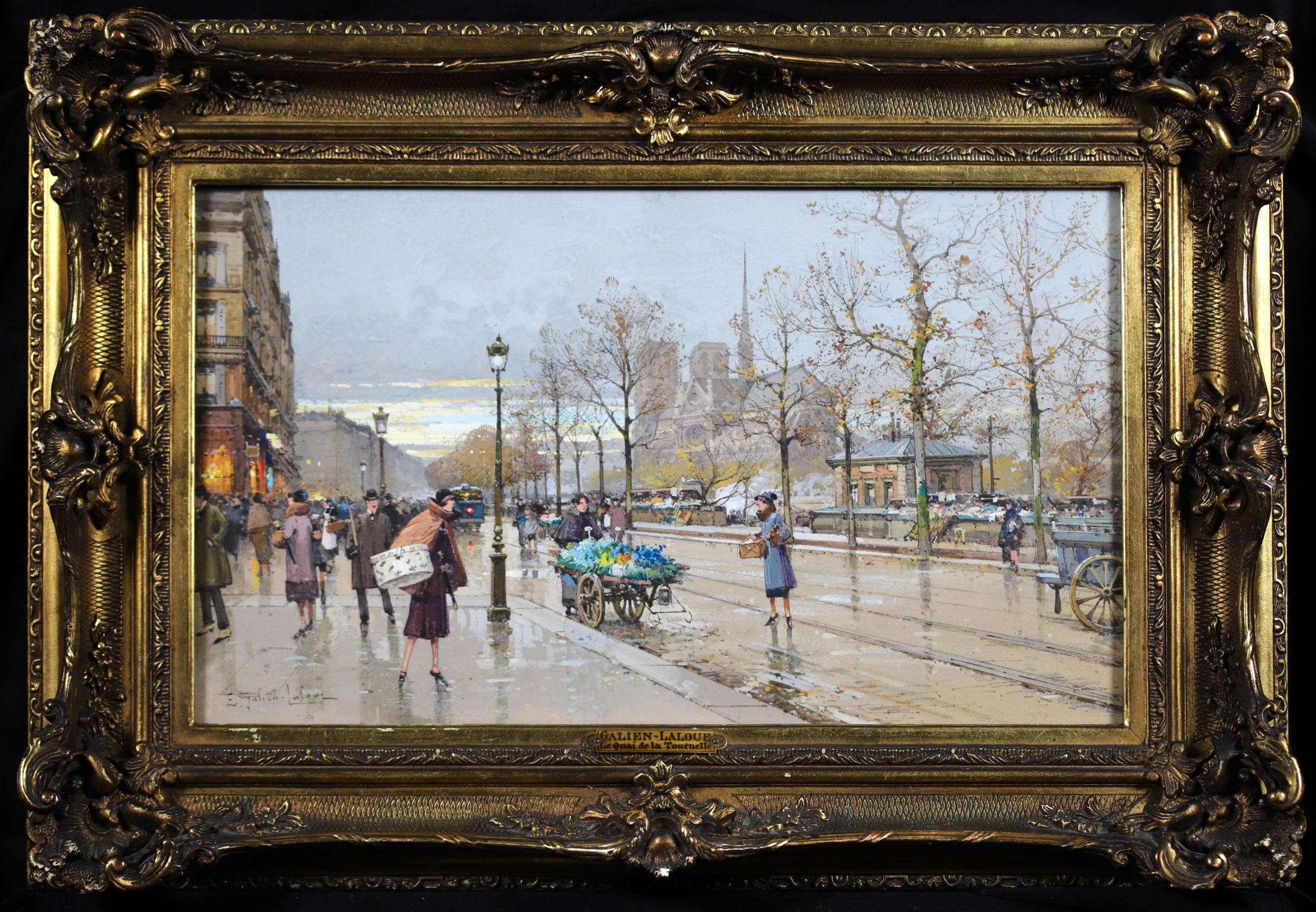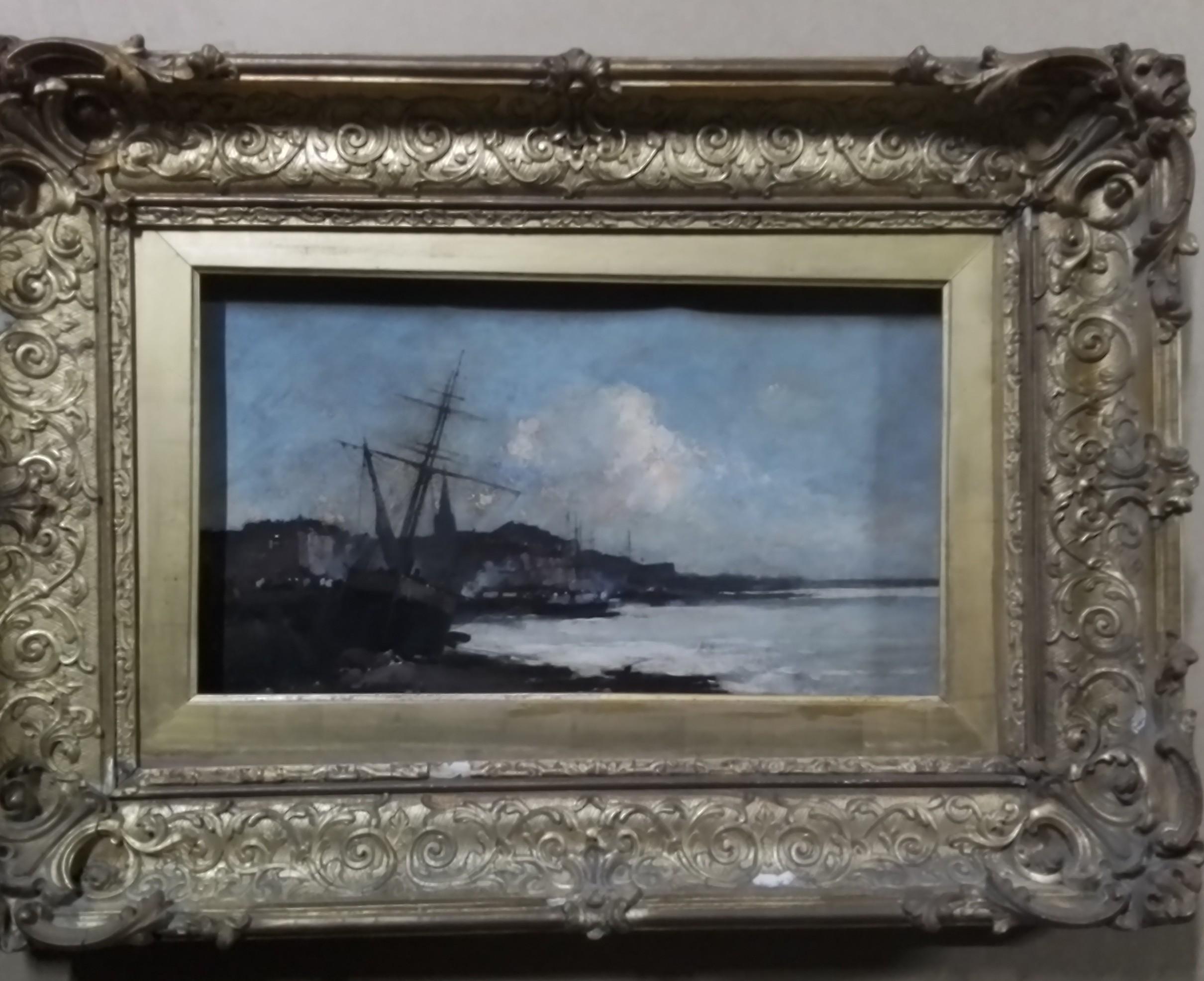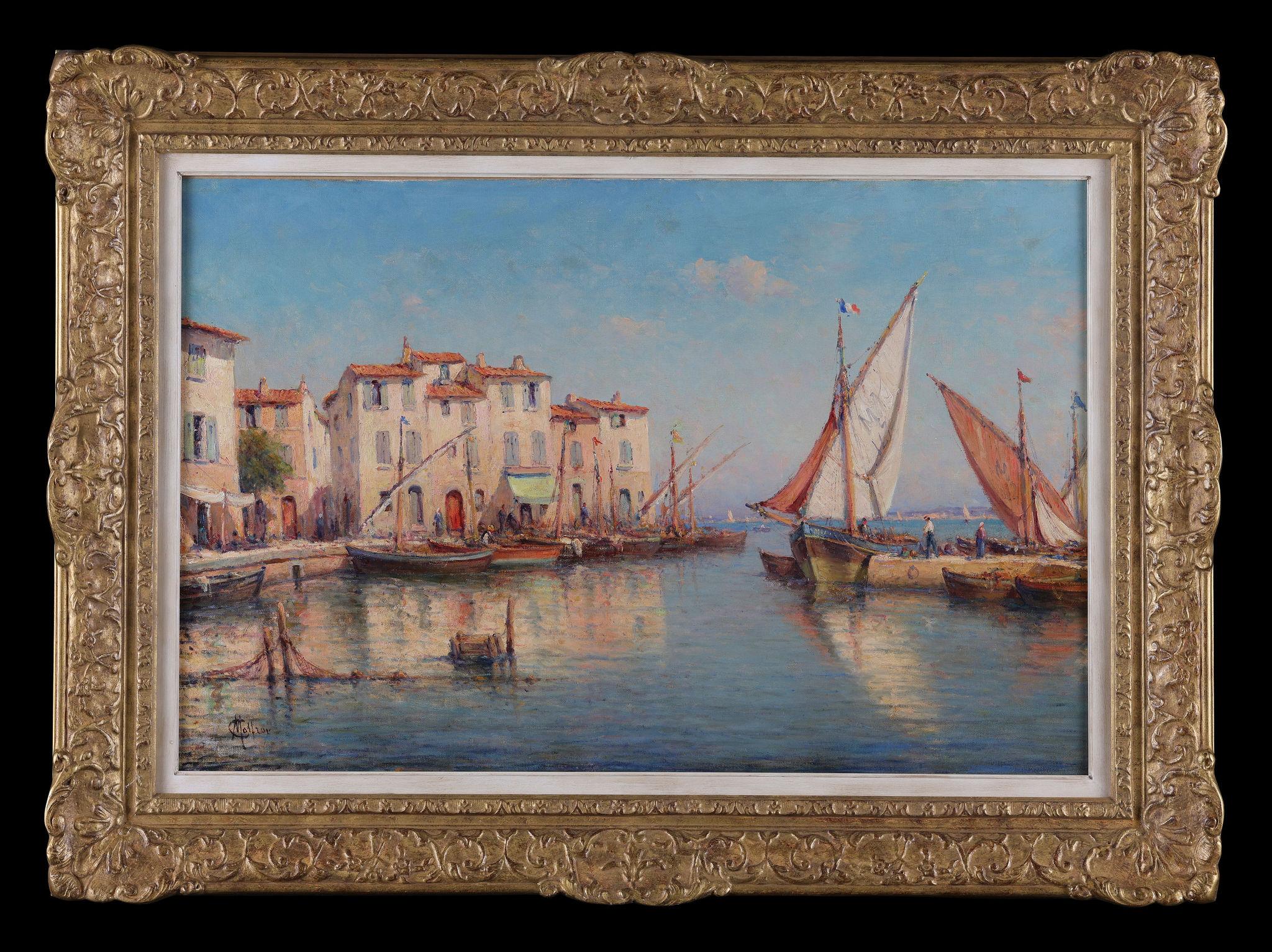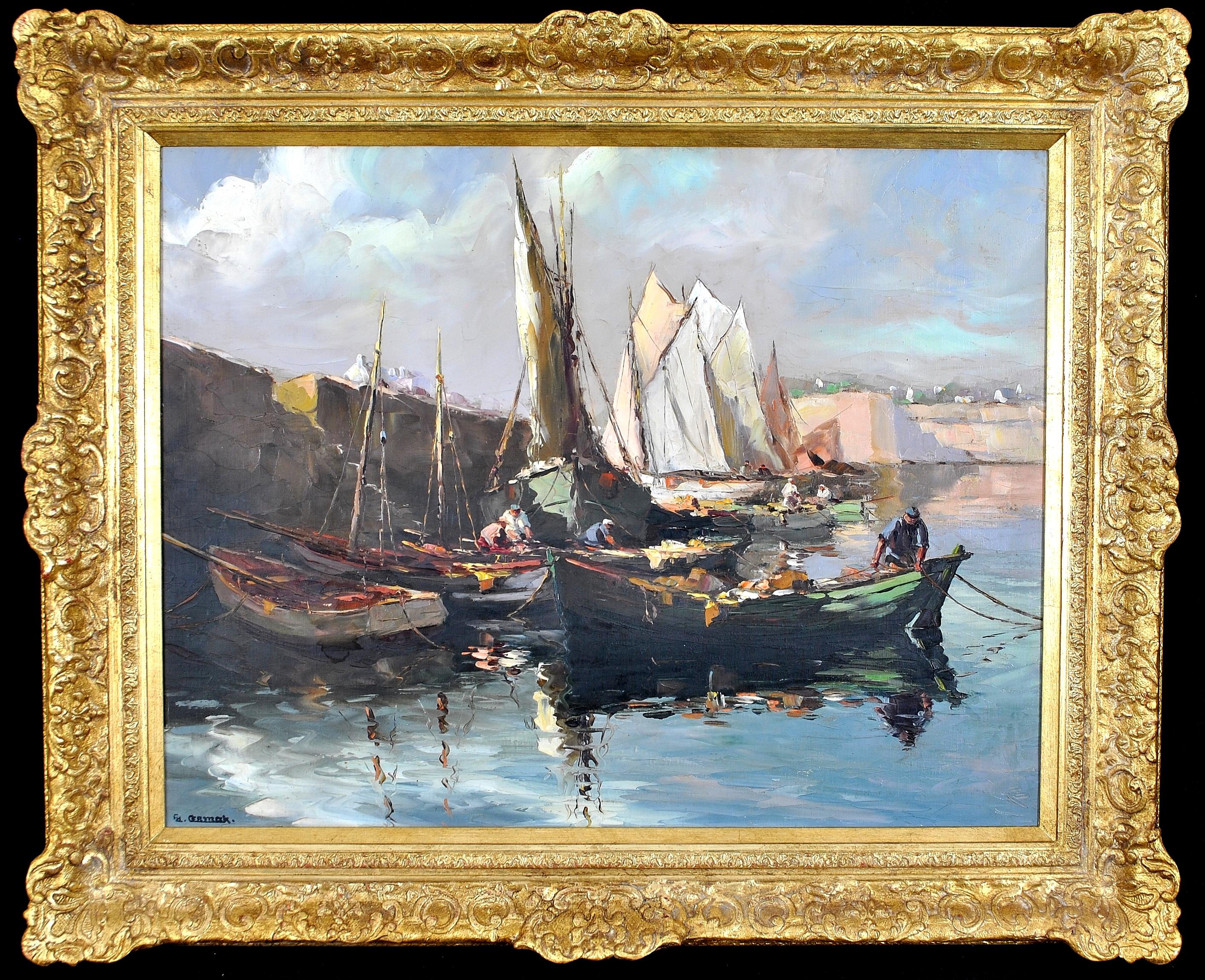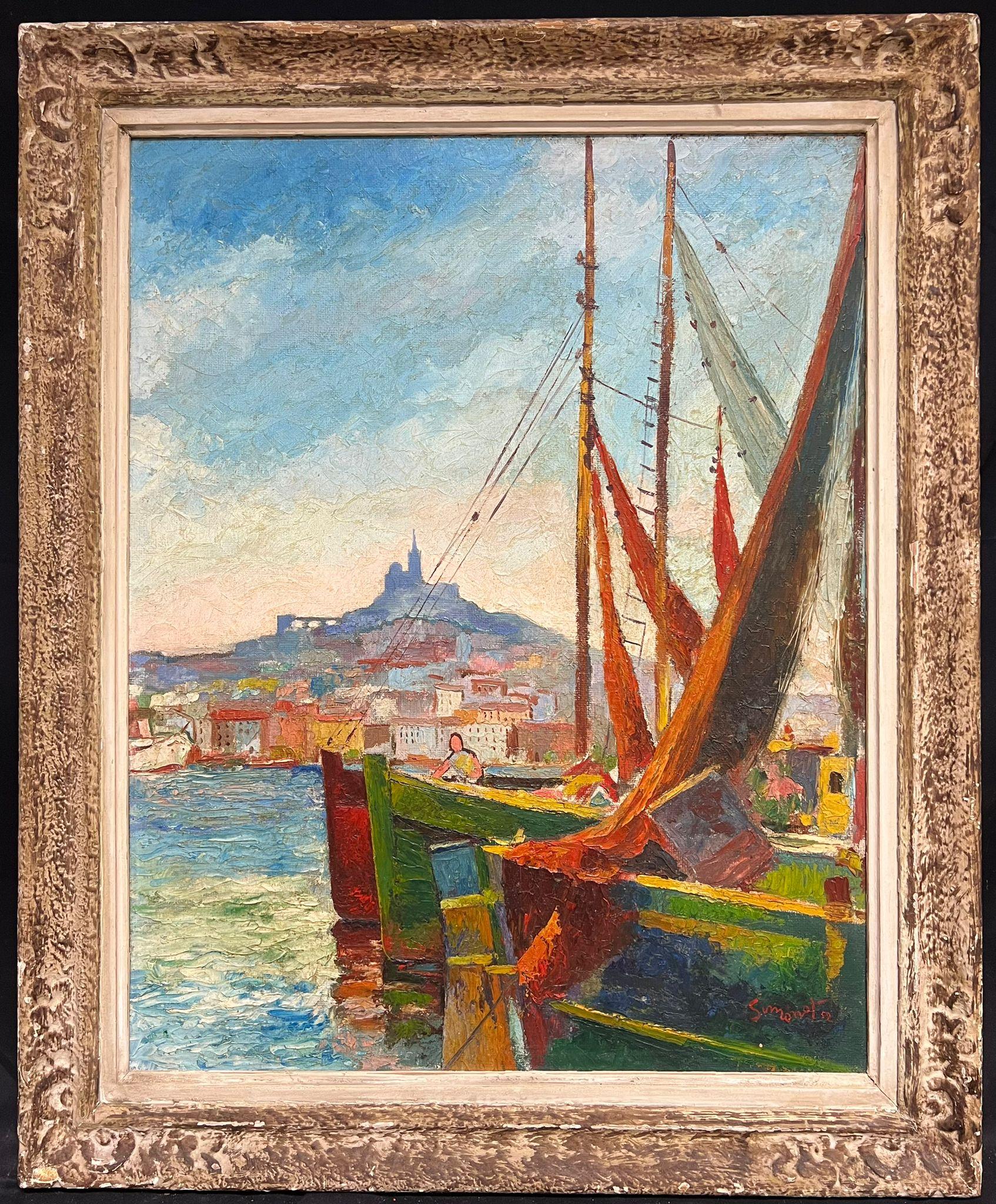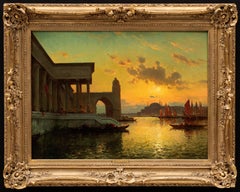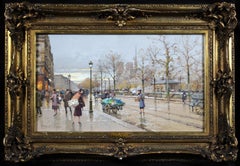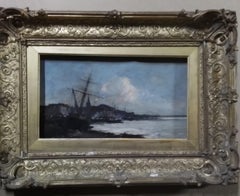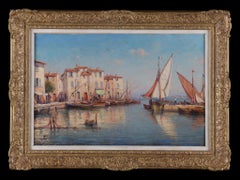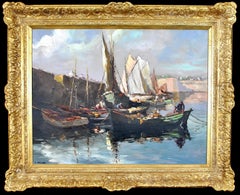Items Similar to "Le Port de Marseille" Eugène Galien Laloue (French, 1854-1941)
Video Loading
Want more images or videos?
Request additional images or videos from the seller
1 of 11
Eugène Galien-Laloue"Le Port de Marseille" Eugène Galien Laloue (French, 1854-1941)
$19,800
£15,204.50
€17,441.95
CA$27,821.32
A$31,158.13
CHF 16,257.80
MX$380,583.12
NOK 206,846.52
SEK 194,977.64
DKK 130,167.16
About the Item
"Le Port de Marseille"
Eugène Galien Laloue (French, 1854-1941)
Gouache and watercolor on paper, original carved and gilded frame.
12 3/8 x 7 3/4 (14 1/2 x 9 5/8 frame) inches
Signed lower left with his pseudonym "Lievin"
Ex collection Frederick H. Schrader, Napa Valley of Schrader Cellars
PROVENANCE:
Conan Hôtel d'Ainay, Lyon, December 13, 2015, lot 59;
Acquired by the present owner from the above.
We thank Mr. Noé Willer for confirming the authenticity of this work, which will be included in his forthcoming Eugène Galien-Laloue catalogue raisonné.
This scintillating, sundrenched view of Marseille is bursting with Mediterranean brightness by Eugène Galien Laloue is richly detailed and signed with his pseudonym "Levien" (the painter used many pseudonyms such as L.DUPUY, J.LIEVIN, E.KERMAINGUY, M.LENOIR, A.MICHEL, L.COURTIER…)
The painting is in perfect condition and retains its original frame, which is also of very high quality and richly detailed. The scene captures the city of Paris in the era of Belle Époque with its numerous entertainments on the boulevard, bright and illuminated store fronts, and the Art Nouveau Metro entrance, etc.
Note the superb white & orange contrast between the snow effect and the lighting.
Eugène Galien-Laloue was a skilled and productive artist, particularly when working in gouache and producing small-scale works. enjoying a considerable reputation in the early years of the 20th century, Laloue painted almost exclusively the most picturesque spots of Paris, notably the Grands-Boulevards. Painting in the happy pre-war period when the city was filled with omnibuses and carriages, Laloue works evoke the atmosphere of turn-of-the-century Paris and retains a clearly important documentary value. Laloue also painted landscapes of Normandy, Seine-et-Marne, Marseilles, Italy and Venice. In 1914 he began painting military scenes. During the 1870s, Laloue painted alongside his friend Charles Jacques in the forests of Fontainebleau.
Eugène Galien Laloue was born on December 11, 1854, in Montmartre, the oldest of nine children. His father Charles died when he was sixteen years old, after which he found him work at the local notary, leaving school to fill the position. Shortly after, however, he felt the nationalistic urge to enlist in the military. Quitting his job and faking his name in 1871, he left for military duty which led him through the end of the Franco-Prussian war of 1870-1871. By then he had decided to become a painter.
For such an eager participant in the military, to turn immediately to painting must have been a reaction against the bloody events of the Franco-Prussian war; a way to forget what he had seen. In 1874 he was employed by the French Railway lines as an illustrator, depicting the rail track that was being laid from Paris to the provinces. Concurrently he began painting the surrounding landscapes as well.
While practical, this was unusual “training” for a young art student. His artistic education seemed to come via his other jobs as well. He exhibited for the first time in 1876 at the Museum of Reims. The following year he exhibited for the first time at the annual Parisian Salon. He preferred executing gouaches since they were less time consuming than his oils and brought comparable prices.
Laloue had a reclusive personality, which also may explain the reasons behind his numerous pseudonyms as Eugène Galien Laloue was particularly adept at establishing several identities, since over the course of his career he worked under three pseudonyms: J. Lievin, E. Galiany and L. Dupuy. While these are three confirmed names that he used, there is the possibility that he used other names as well. Even his name “Galien” is questionable, since on occasion he spelled it with one “l” and on his birth certificate it is spelled “Gallien”. Being contractually bound to paint for a gallery, this may have also necessitated desire for adopting numerous pseudonyms.
Despite his reclusive nature, Laloue depicted Paris and the surrounding landscape with his cool palette; in doing so he balanced his architectural interest in Paris with several landscape views and was an equally if not more proficient draughtsman. He preferred the solitariness of his studio and thus did not paint his works entirely on-site. Unlike many other artists of his day, he did not like to travel and many of his views of other cities or countries were inspired by postcards and photographs; an increasing tendency with many artists as photography became a more established method of use.
The depiction of his natural environment was an interesting theme for an artist who did not necessarily seek to connect with nature and while painting en plein-air. Laloue “hated to walk in any mud and even a blade of grass bothered him.” (Noë Willer, Eugène Galien-Laloue: 1854-1941, New York: Alexander Kahan, 1999, pg. 16)
“He was not eccentric but always conservative, practically a royalist. He was obsessed with his painting. In his private life he found simplicity alluring: he married three sisters, one after the other (beginning with the youngest and ending with the oldest). They had all lived next door to him. He lived a monastic life. All worldly pursuits, games, alcohol, the pleasure of the flesh were not for him. Riding his bicycle to places in Paris to paint was his only physical exercise.”
Laloue was more concerned with the sale of his paintings than the associating with his contemporaries who were working in the same manner. He kept scrupulous notes regardless of the fact that he sold each painting for the same price. In 1889t he took a five-year sabbatical, during which time his daughter was born; he returned to the exhibition at the Paris Salon in 1904. During the first two decades of the twentieth century, Laloue also exhibited at Dijon, Orléans, Versailles, Roubaix, Saint Etienne, Bordeaux, Monte Carlo, Hautecoeur, Angers. At an exhibition in Saint Quentin, his work received the following review (Willer, pg. 33):
“Once again we mention Mr. Eugène Galien Laloue for his lovely gouaches, as full as oils, which show most picturesquely the popular quarters of Paris.”
As World War I broke out, aside being too old for military service, Laloue was nevertheless exempt from military service because he had volunteered for the Franco-Prussian war. Instead, he took to his canvas and depicted scenes of soldiers in the midst of battle, paying close attention to the setting and other details such as their costumes and the action of their involvement. His own previous military experience must have inspired his depictions, since in his military scenes his figures are given a more prominent role than in either his Parisian scenes or his landscape paintings. He identified with these soldiers.
Galien Laloue continued to paint until 1940 when he broke the arm with which he held his brush.
He moved out of Paris many times to depict the landscapes of Normandy and the surroundings of Barbizon, making his home for a short time in Fontainebleau. While his Parisian scenes were often of the fall and winter, he preferred to document the landscape during the brighter months of spring and summer. He also documented life along the canals and banks of the sea and rivers, showing an interest in maritime exploits. Throughout his career Laloue had become very popular with both French and especially American artists and collectors. Laloue continued to paint the same scenes of Paris throughout his career.
Eugène Galien-Laloue died in his daughter’s house in Chérence, where they had taken refuge at the beginning of the Second World War, on April 18th, 1941. His works of art can be found in numerous important public and private collections around the world.
- Creator:Eugène Galien-Laloue (1854 - 1941, French)
- Dimensions:Height: 9.63 in (24.47 cm)Width: 14.5 in (36.83 cm)
- Medium:
- Movement & Style:
- Period:
- Condition:The painting and the original frame are in very good condition. The frame does some small, though typical knicks for a piece of this age.
- Gallery Location:SANTA FE, NM
- Reference Number:1stDibs: LU1408216589792
About the Seller
5.0
Platinum Seller
Premium sellers with a 4.7+ rating and 24-hour response times
Established in 1995
1stDibs seller since 2020
119 sales on 1stDibs
Typical response time: 1 hour
- ShippingRetrieving quote...Shipping from: Santa Fe, NM
- Return Policy
Authenticity Guarantee
In the unlikely event there’s an issue with an item’s authenticity, contact us within 1 year for a full refund. DetailsMoney-Back Guarantee
If your item is not as described, is damaged in transit, or does not arrive, contact us within 7 days for a full refund. Details24-Hour Cancellation
You have a 24-hour grace period in which to reconsider your purchase, with no questions asked.Vetted Professional Sellers
Our world-class sellers must adhere to strict standards for service and quality, maintaining the integrity of our listings.Price-Match Guarantee
If you find that a seller listed the same item for a lower price elsewhere, we’ll match it.Trusted Global Delivery
Our best-in-class carrier network provides specialized shipping options worldwide, including custom delivery.More From This Seller
View AllMarine Painting "Trois Pêcheurs" Louis Pastour (France, 1876-1948)
Located in SANTA FE, NM
"Trois Pêcheurs"
Louis Pastour (France, 1876-1948)
Oil on board
Signed l.l.
7 7/8 x 4 7/8 (8 1/8 x 11 1/8 frame) inches
Louis Pastour was called the “...
Category
1930s Post-Impressionist Landscape Paintings
Materials
Oil, Board
"The Great View of Venice" Antoine Bouvard Snr. (French, 1875-1955)
By Antoine Bouvard Snr.
Located in SANTA FE, NM
"The Great View of Venice"
Antoine Bouvard Snr. (French, 1875-1955)
Oil on canvas, original, gilt wood frame,
Signed, lower right
20 3/4 x 28 1/2 (28 1/2 x 37 frame) inches
Anto...
Category
1930s Impressionist Landscape Paintings
Materials
Canvas, Oil
"En Provence" Raymond Allègre (1857-1933)
By Allegre Raymond
Located in SANTA FE, NM
"En Provence"
Raymond Allègre (France, 1857-1933)
Circa 1900
Oil on wood panel
Signed lower left, countersigned and titled on the back
13 1/2 x 9 (30 3/4 x 25 1/8 frame) inches
It'...
Category
1890s Impressionist Landscape Paintings
Materials
Oil, Wood Panel
“View of Villefranche-sur-Mer” Raymond Thibesart Raymond Thibesart (1874-1968)
By Raymond Thibesart
Located in SANTA FE, NM
“View of Villefranche-sur-Mer”
Raymond Thibesart (France, 1874-1968)
Oil on canvas, circa 1920s
24 x 32 1/2 (29 x 38 1/2 framed) inches
Bathed in the soft and steamy light of the S...
Category
1920s Post-Impressionist Landscape Paintings
Materials
Canvas, Oil
“View of Gardanne, 1925" Louis Gautier (French, 1855-1947)
Located in SANTA FE, NM
“View of Gardanne, 1925"
Louis Gautier (French, 1855-1947)
Oil on cardboard Signed and dated 1925 lower left,
Dedicated lower right: "à Monsieur Angeli, Bien cordially"
Titled, dated...
Category
1920s Landscape Paintings
Materials
Cardboard, Oil
"Basilica di Santa Maria della Salute, Venice" Raymond Allègre (1857-1933)
By Allegre Raymond
Located in SANTA FE, NM
"Basilica di Santa Maria della Salute, Venice"
Raymond Allègre (France, 1857-1933)
Circa 1900
Oil on wood panel
Signed lower left
13 1/2 x 9 (22 1/2 x 17 frame) inches
The saturate...
Category
1890s Impressionist Landscape Paintings
Materials
Oil, Wood Panel
You May Also Like
Le Quai de Tournelle - Impressionist Cityscape Gouache by Eugene Galien-Laloue
By Eugene Galien-Laloue
Located in Marlow, Buckinghamshire
Signed impressionist gouache on paper figures in landscape circa 1910 by French painter Eugene Galien-Laloue. The piece depicts a street scene at the Quai de la Tournelle...
Category
1910s Impressionist Figurative Paintings
Materials
Gouache, Paper
Boat in Harbor - At a Normandy harbor - Galien laloue - oil on canvas -
By Eugene Galien-Laloue
Located in PARIS, FR
Conditions : Good overall Conditions. Oil on canvas. Highly detailed composition in a 19th century original frame. This painting will be included in Volume II of the catalog of the w...
Category
Late 19th Century Impressionist Landscape Paintings
Materials
Oil
'Le Port de Martigues'. A Port in Martigues Provence, South of France. Oil paint
By Charles Malfroy
Located in St. Albans, GB
Charles MALFROY
French 1862 - 1918
Canvas size: 24 x 36" (60 x 90cm)
Outside Frame Size: 32 x 44" (82 x 112cm)
Inscribed on the reverse
Charles Malfroy was born on May 22nd 1862 i...
Category
Early 20th Century Post-Impressionist Landscape Paintings
Materials
Oil
Côte d'Azur Harbor - French Impressionist Saint-Tropez Riviera Provence Painting
Located in Sevenoaks, GB
This beautiful large impressionist oil on canvas by French artist Charles Cermak was painted in the 1930's. The work depicts colourful sailing boats in a harbor on the Côte d'Azur, m...
Category
1930s Impressionist Landscape Paintings
Materials
Canvas, Oil
Mid Century French Oil Painting Marseille Sunny Harbour with Fishing Boats
Located in Cirencester, Gloucestershire
Marseille Harbor
French artist, circa 1952
signed oil on board, framed
Framed: 29 x 24 inches
Board : 24 x 19 inches
Provenance: private collection, the South of France
Condition: ve...
Category
Mid-20th Century Impressionist Landscape Paintings
Materials
Oil
Eugène Galiany aka Eugène GALIEN-LALOUE (1854-1941) Impressionist Oil Painting
Located in Holywell, GB
Eugène Galiany aka Eugène GALIEN-LALOUE (1854-1941)
A delightful pastoral Normandy landscape by the master of this genre Galien-Laloue. Signed E Galiany and presented in a walnut ...
Category
Early 1900s Impressionist Landscape Paintings
Materials
Oil
More Ways To Browse
French Military Art
Pre War Art
Framing Antique Documents
French Military Paintings
French Art Nouveau Framed Art
18th Century French Landscape
Antique World War 1
Prussian Painting
Metro Sign
France Postcard
French Bicycle
Antique Postcards
Mud Century Painting
Franco Prussian
Franco Prussian War
Dior Postcards
Antique Exercise
Gouache 18th Century
